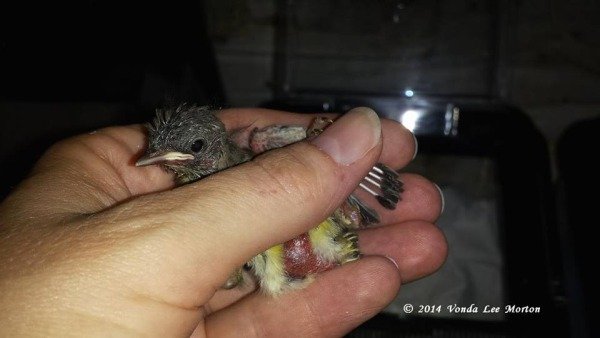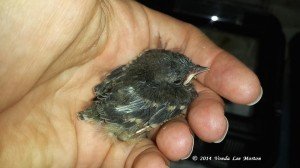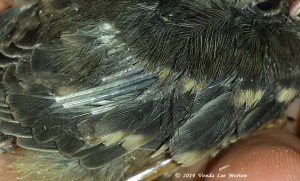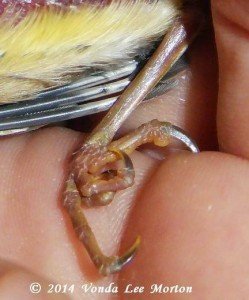
“Okay, fellow songbird rehabbers,” wrote Vonda Lee Morton of Laurens Wildlife Rescue on her FaceBook page. “Is this a Song Sparrow? Tiny little pre-fledgling — nearly fully feathered. Belly’s not bruised; skin tone his purplish-red, as is gape. Feathers on belly, nearly obscured by my thumb, yellow. Quiet little “chip” for begging call. Nearly inaudible.”
Spring through summer is baby season, and the human population ventures outside and finds little creatures in their backyard, their garden, their porch, the edge of the trail, the sidewalk, the train platform, etc. Sometimes bird rehabbers who end up with tiny, semi-feathered little mystery birds end up playing a game called “Name That Bird.”
Nestlings are identified by size, head shape, gape (the inside of their mouth) color, gape flanges (the part of their beaks where the upper and lower mandibles come together) color, and/or by their begging calls. Some are impossible to mistake (Blue Jays, with their big heads, bright red gapes, and bright yellow gape flanges); or House Sparrows (whose sweet little chirps become less endearing once one realizes they almost never, ever stop).
When they turn into fledglings feather color plays a part, although the feathers of fledglings differ markedly from those of their parents, which differ from those of their species a year old, two years old, in non-breeding plumage, in winter/summer plumage, etc. Hence: Name That Bird. Hence: phone calls to birder friends.
In any case, Vonda posed the question and the photo; ideas poured in from various rehabbers, who passed it around to other rehabbers (FaceBook can be a wonderful thing). More photos were posted. Commentary followed.
“That’s not a very sparrowy beak. Eastern Kingbird? Where are you, Vonda, anyway? Aha, Georgia, so it’s too small for a Carolina Wren and there aren’t any House Wrens in your area during breeding season.”
“American Goldfinch? Wrong color legs. How much does he weigh? 9.8 grams. Does he wing-shimmy when he begs? A little bit. Is there a tiny hook on the tip of the bill? If not, that rules out a vireo.”
“Flycatcher? Eastern Peewee? Where did he come from?”
“He came from a pine tree above two of my vets’ driveway in a fairly heavily wooded area. At least, that was the closest tree to where he was found.”
“Can you post a begging video? Sure, here you go:” https://www.youtube.com/watch?v=dZ8QwaHZtY0&feature=youtu.be
“You don’t have many breeding warblers down there, do you? Kentucky or Prairie would be the only possibilities. Oh, wait, you also have Hooded and Prothonotary! I have no idea what those would look like.”
“Gape is wrong for flycatchers, theirs is orangish and his is purple-red. Here’s a gaping shot. BTW: Type “(species name) baby” into Google Images – do NOT use the terms hatchling, nestling or fledgling, or you’ll never get decent results.”
“I’d say Orchard Oriole, but he’s too big. Ever rehabbed a Baltimore Oriole? They’re a blast! Blackbird mentality. Very goofy and vocal.”
For four days, Vonda posted photos and updates. The mystery bird’s weight dropped slightly over a three-day period and fell drastically the following day, provoking a wave of alarm; but then he rebounded and began preening. Vonda posted faithfully, even though between rehabbing and working she was living on almost no sleep. Cornell Lab of Ornithology responded to her initial photo with “Great-crested Flycatcher,” which she refused to accept (“I *do* know my flycatchers,” she wrote), and sent them more photos and the video.
Then, he died. “Dammit!” wrote Vonda. “He seemed so much improved today, I thought he might have had a chance. I just hate to lose the little guy.”
The next morning Cornell’s Kevin McGowan responded to Vonda’s additional emails, identifying the mystery bird and including a photo he had found on a Flickr account of an exact duplicate. The little orphan who had appeared out of nowhere, puzzled experts, and received almost 140 Facebook comments was a Pine Warbler.
Rest in peace, little guy.















Leave a Comment